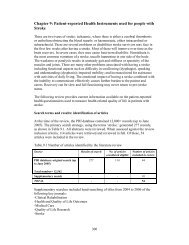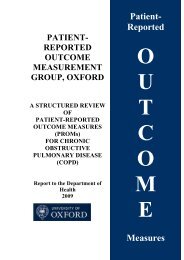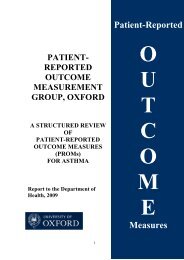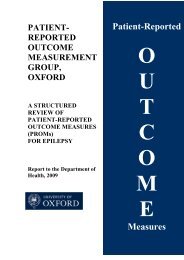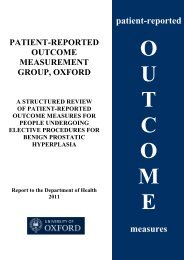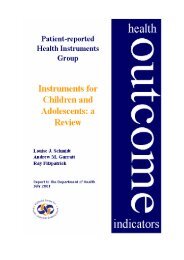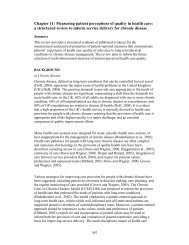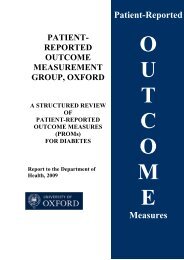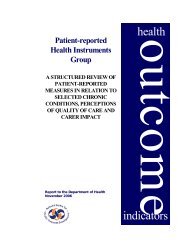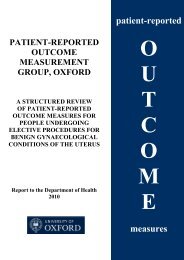2010 review - Patient-Reported Outcomes Measurement - University ...
2010 review - Patient-Reported Outcomes Measurement - University ...
2010 review - Patient-Reported Outcomes Measurement - University ...
Create successful ePaper yourself
Turn your PDF publications into a flip-book with our unique Google optimized e-Paper software.
satisfaction with various aspects of life, while the second measures the importance of those<br />
same aspects. Importance ratings are used to weight the satisfaction responses, so that scores<br />
reflect satisfaction with those aspects of life most valued by the respondent. Scores are<br />
calculated for quality of life overall and in four domains: Health and functioning (HQOL),<br />
Psychological/spiritual (PQOL), Social and economic (SQOL), and Family (FQOL); higher<br />
scores indicate greater perceived quality of life. Two items relating to dyspnoea and lifestyle<br />
changes due to cardiac problems were added to the generic QLI to create the 35-item QLI-<br />
CV.<br />
Four nurse-led studies were identified which support the use of the QLI-CV with US patients<br />
undergoing elective coronary procedures, the most recent being from 2005. Three of the<br />
studies examined outcomes of CABG; one examined PCI.<br />
Internal consistency reliability of QLI-CV subscales was high, with Cronbach’s alphas<br />
ranging 0.79-0.90 in a study comparing QoL pre- and post-CABG or PTCA (Papadantonaki<br />
et al., 1994). Similar values (range 0.76-0.93) were found in a study comparing QoL after<br />
CABG or PTCA (Skaggs and Yates, 1999), while alphas of 0.91 and 0.95 were noted in a<br />
study of pre- and post-operative QoL in women undergoing CABG (Penckofer et al., 2005).<br />
QLI-CV HQOL and PQOL domains discriminated between PTCA patients who did and did<br />
not experience angina post-operatively in a study comparing QoL after CA and CABG<br />
(Skaggs & Yates, 1999). HQOL, PQOL, and SQOL subscales discriminated men and women<br />
in a study examining gender differences in the experience of CABG (Keresztes et al., 2003).<br />
Responsiveness of the measure was illustrated by statistically significant score changes in<br />
overall QoL and the Health and functioning subscale (Papadantonaki et al., 1994; Penckofer<br />
et al., 2005), though changes on the other subscales were non-significant. HQOL, FQOL, and<br />
SQOL subscales showed responsiveness to change in the study by Keresztes and colleagues<br />
(2003).<br />
h. Seattle Angina Questionnaire, SAQ (Spertus et al., 1994b, 1995)<br />
The SAQ measures the physical and emotional effects of CAD over the previous four weeks.<br />
It comprises 19 items in five domains, namely Exertional Capacity or Physical Limitation<br />
(PL, nine items), Anginal Stability (AS, one item), and Anginal Frequency (AF, two items),<br />
patients’ satisfaction with their treatment (TS, four items), and Disease Perception/Quality of<br />
Life (QL, three items). There are five or six response options for each question, which are<br />
assigned ordinal values. Scores within each dimension are summed and transformed into a 0-<br />
100 range, with higher scores indicating better function, fewer symptoms, and better quality<br />
of life; there is no overall summary score. A change in score of ten points reflects change that<br />
is meaningful to patients (Spertus et al., 1995); however, in a later study the developer<br />
suggests that a five- to eight-point change is clinically significant (Spertus et al., 2000).<br />
A UK version of the SAQ, reduced to 14 items in three dimensions and with some linguistic<br />
modifications, has been evaluated for validity, reliability, and responsiveness with angina<br />
patients (Garratt et al., 2001, UK). However, no further evidence for this version of the<br />
instrument was found, and it does not appear to have been tested with patients undergoing<br />
revascularisation procedures.<br />
Twenty-two studies were identified which used the SAQ to assess outcomes after elective<br />
surgical revascularisation. Five of these were with UK samples (Agarwal et al., 2009; Al-<br />
28



